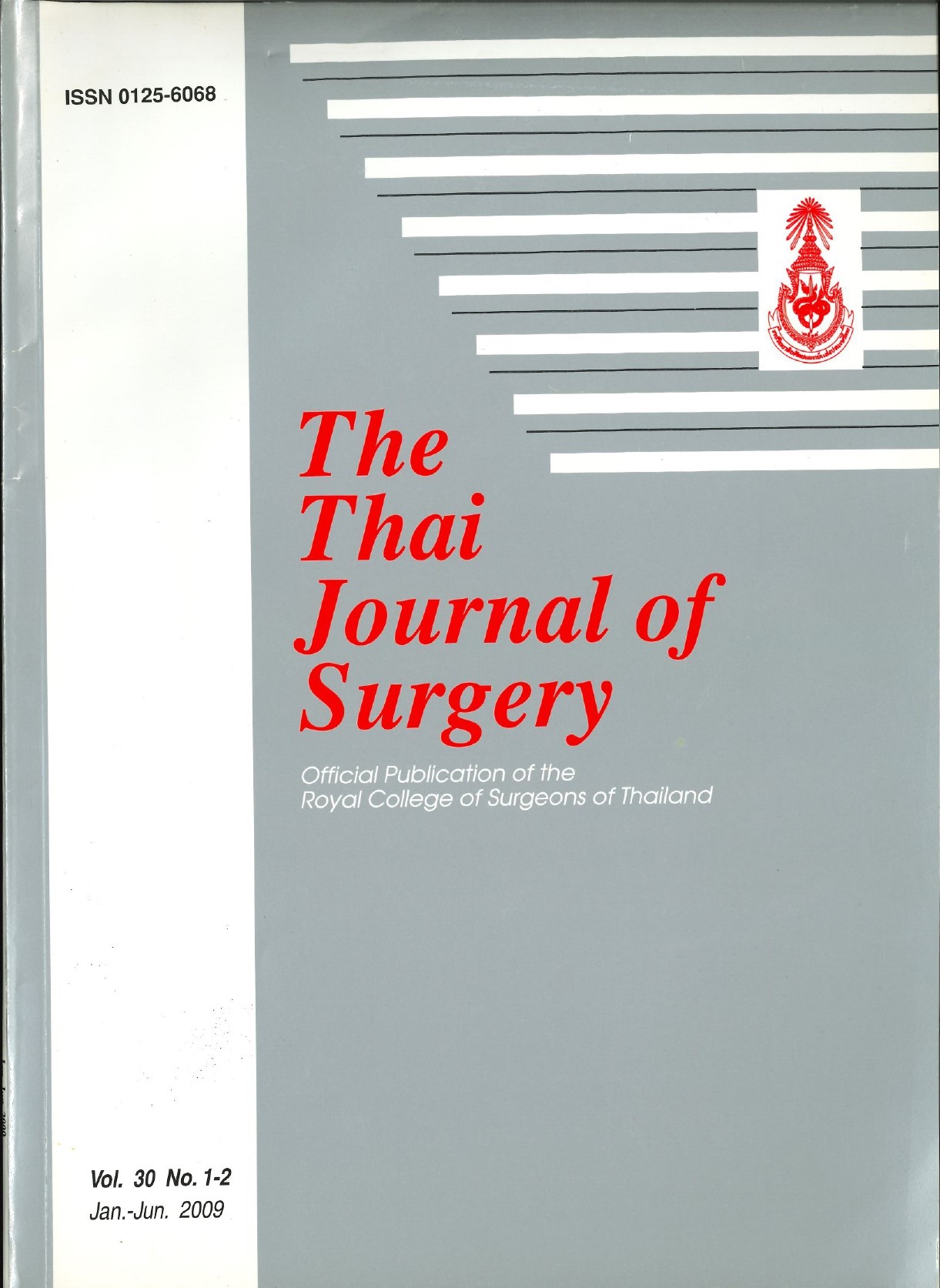Characteristic of Mixed Hyperplastic-adenomatous Polyps at Ramathibodi Hospital
Keywords:
Mixed hyperplastic-adenomatous polyps, serrated adenomaAbstract
Introduction: Mixed hyperplastic-adenomatous polyps contain foci of hyperplastic change with dysplasticadenomatous change. These polyps are likely to be heterogeneous at a molecular level and may predispose to
sporadic colorectal cancer through a distinct pathway. Aim of this study was to describe characteristics of mixed
hyperplastic-adenomatous polyps in Thai patients.
Methods: A retrospective study included 272 polyps from 201 patients detected by colonoscopy in the
General Surgery Unit at Ramathibodi Hospital during the past one year period (Jan-Dec 2007).
Results: There were 141 mixed hyperplastic-adenomatous polyps from 104 patients. There were 63
(60.5%) male and 41 (39.5%) female. The mean age was 62 (21-87 years). Most polyps (63.8%) were in left colon
especially sigmoid colon (29.2%). Size of polyps was ≤0.5 cm in 69%, 0.6-1 cm in 23.8%, 1.1-2.0 cm in 4.7% and
> 2 cm in 2.4%. Morphology of polyps was sessile in 56.8%, pedunculated polyps in 34% and others were flat
polyps (9.2%). All detected polyps were endoscopically removed, which technically failed in 1 patient.
Polypectomy (53.3%) was performed in medium and large size polyps. Hot biopsy (39%) was the main treatment
in small polyps. Of 141 polyps identified, 54.8% of polyps were serrated adenoma. There were severe dysplasia
in 5.7% and carcinoma in situ in 1.4%. Only 0.7% of removed polyps contain adenocarcinoma.
Conclusion: The majority of colorectal polyps at our hospital are small size sessile mixed hyperplasticadenomatous
polyps mainly located in left-sided colon. These polyps should be recognized and endoscopically
removed to decrease risk of subsequent colorectal cancer.
References
Digest Liver Dis 2001;33:305-12.
2. Urbanski SJ, Kossakowska AE. Mixed hyperplastic adenomatous
polyps-An underdiagnosed entity. Am J Surg Pathol
1984;8:551-6.
3. Cooper HS, Patchefsky AS, Marks G. Adenomatous and
carcinomatous changes within hyperplastic colonic
epithelium. Dis Colon Rectum 1979;22:152-6.
4. Estrada RG, Spjut HJ. Hyperplastic polyps of the large
bowel. Am J Surg Pathol 1980;4:127-33.
5. Franzin G, Novelli P. Adenocarcinoma occuring in a hyperplastic
(metaplastic) polyp of the colon. Endoscopy 1982;14:
28-30.
6. Jass JR, Lino H, Ruszkiewicz A, et al. Neoplastic progression
occurs through mutator pathways in hyperplastic polyposis
of the colorectum. Gut 2000;47:43-9.
7. Longacre TA, Fenoglio-Preiser CM. Mixed hyperplastic
adenomatous polyps/serrated adenomas. A distinct form
of colorectal neoplasia. Am J Surg Pathol 1990;14:524-37.
8. Goldstein NS, Bhanot P, Odish E, et al. Hyperplastic-like
colon polyps that preceded microsatellite-unstable
adenocarcinomas. Am J Clin Pathol 2003;119:778-96.
9. Cunningham KS, Riddell RH. Serrated mucosal lesions of the
colorectum. Curr Opin Gastroenterol 2006;22:48-53.
10. Matsumoto T, Mizuno M, Shimizu M, et al. Serrated adenoma
of the colorectum: colonoscopic and histologic features.
Gastrointest Endosc 1999;49:736-42.
11. Song SY, Kim YH, Yu MK, et al. Comparison of malignant
potential between serrated adenomas and traditional
adenomas. J Gastroenterol Hepatol 2007;22:1786-90.
12. William GT, Arthur JF, Bussey HJR, et al. Metaplastic polyps
and polyposis of the colorectum. Histopathology 1980;4:155-
70.
13. O’Brien MJ, Winawer SJ, Zauber AG, et al. The National
Polyp Study. Patient and polyp characteristics associated
with high-grade dysplasia in colorectal adenoma.
Gastroenterol 1990;98:371-9.
14. Wisedopas N, Thirabanjasak D, Taweevisit M. A retrospective
study of colonic polyps in King Chulalongkorn Memorial
Hospital. J Med Assoc Thai 2005;88 Suppl 4: S36-41.
15. Li SC, Burgart L. Histopathology of serrated adenoma, its
variants, and differentiation from conventional adenomatous
and hyperplastic polyps. Arch Pathol Lab Med
2007;131:440-5.
16. Torlakovic E, Skovlund E, Snover DC, et al. Morphologic
Reappraisal of serrated colorectal polyps. Am J Surg Pathol
2003;27:65-81.
17. Higuchi T, Sugihara K, Jass JR. Demographic and
pathological characteristics of serrated polyps of
colorectum. Histopathology 2005;47:32-40.
Downloads
Published
How to Cite
Issue
Section
License
Articles must be contributed solely to The Thai Journal of Surgery and when published become the property of the Royal College of Surgeons of Thailand. The Royal College of Surgeons of Thailand reserves copyright on all published materials and such materials may not be reproduced in any form without the written permission.



